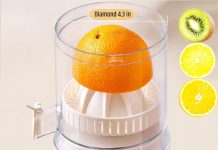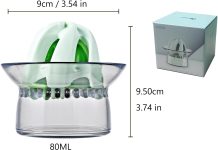Fruit enthusiasts always ponder over the dilemma of whether it is more beneficial to extract juice from their favorite fruits or to simply cut them up and consume them as is. In this article, we take a closer look at the pros and cons of juicing fruit versus consuming it in its whole form. From the nutritional value to the convenience factor, we weigh the options to help you make a well-informed decision that suits your lifestyle and health goals. Get ready to explore the world of fruits and discover the best way to enjoy their flavors and nutrients.
Review contents
Benefits of Juicing Fruit
Increased nutrient absorption
Juicing fruit allows for increased nutrient absorption as the process breaks down the cell walls of fruits, making it easier for our bodies to extract the nutrients. This means that we can access and benefit from a greater amount of vitamins, minerals, and antioxidants that fruits have to offer.
Quick and easy way to consume a variety of fruits
Juicing provides a quick and convenient way to consume a variety of fruits in one go. By blending different types of fruits together, we can create a delicious and nutritious juice that includes a wide range of vitamins, minerals, and antioxidants. This can be especially beneficial for those who struggle to eat enough fruits throughout the day.
Higher concentration of vitamins and minerals
When we juice fruits, we are able to extract the juice, which contains a higher concentration of vitamins and minerals compared to consuming whole fruits. This is because the juice is a concentrated form of the nutrients found in the fruit, and by removing the fibrous parts, we can access the full nutritional content.
Easy digestion and absorption
One of the key benefits of juicing fruit is the easy digestion and absorption of the nutrients. Since the fiber is removed during the juicing process, our bodies don’t have to work as hard to break down the fruits. This can be particularly helpful for those with digestive issues or individuals who have difficulty digesting whole fruits.
Drawbacks of Juicing Fruit
Loss of fiber
One of the main drawbacks of juicing fruit is the loss of fiber. Fiber is an essential component of our diet as it aids in digestion, helps regulate blood sugar levels, and promotes satiety. When we juice fruit, we remove the fiber, which can lead to a loss of these important benefits.
Increased sugar intake
Juices tend to have a higher sugar content compared to whole fruits. This is because the process of juicing concentrates the sugars present in the fruits, leading to a more concentrated form of sugar. While the natural sugars in fruit are healthier than added sugars, it’s still important to be mindful of our sugar intake, especially for those with diabetes or individuals trying to manage their weight.
Less filling compared to whole fruit
Since juicing removes the fiber, which contributes to the feeling of being full, juices may be less filling compared to consuming whole fruits. This can result in increased snacking or overconsumption of calories throughout the day. It’s important to be mindful of portion sizes when enjoying fruit juices to ensure that we maintain a balanced diet.
Requires a juicer or blender
To juice fruit, a juicer or blender is typically required. While these appliances can be a great investment for those who enjoy juicing, they may not be accessible or affordable for everyone. This can limit the ability to juice fruit and opt for other methods of fruit consumption.
Benefits of Cutting Fruit
Retains natural fiber content
When we cut fruit into bite-sized pieces and consume it, we retain the natural fiber content of the fruit. Fiber is essential for healthy digestion, aiding in regular bowel movements, and promoting a feeling of fullness. By cutting fruit, we ensure that we consume the beneficial fiber along with the other nutrients in the fruit.
Provides a sense of fullness
Cutting fruit into smaller pieces and eating it can provide a sense of fullness due to the fiber content. This can be particularly helpful for individuals aiming to manage or lose weight. The act of chewing and eating fruit can also help to slow down eating, allowing our bodies to register feelings of fullness more effectively.
Can be easily consumed on-the-go
Cutting fruit into convenient, bite-sized pieces makes it easy to consume on-the-go. Whether we’re heading to work, school, or the gym, having pre-cut fruit allows us to enjoy the benefits of fruit without the hassle of peeling or preparing it. It’s a convenient option for those who lead busy lifestyles but still want to incorporate fruits into their diet.
No additional equipment required
Unlike juicing, which requires a juicer or blender, cutting fruit does not require any additional equipment. All that’s needed is a knife and a cutting board to transform whole fruits into bite-sized pieces. This makes cutting fruit a cost-effective and easily accessible option for everyone.
Drawbacks of Cutting Fruit
Slower nutrient absorption
When we cut fruit into smaller pieces, it takes longer for our bodies to break down the food and absorb the nutrients. This means that the process of obtaining the nutrients from the fruit may take more time compared to juicing. However, this slower absorption can have its benefits, particularly for individuals with diabetes or those who are looking for steadier blood sugar levels.
Less variety in fruit consumption
When we choose to cut fruit, we may be limited in the variety of fruits we consume. Some fruits, such as pomegranate or passionfruit, can be challenging to cut and eat in their whole form. This may lead to a narrower range of fruit consumption compared to juicing, where we can easily blend different fruits together to create unique flavors.
Challenges in consuming certain fruits like pomegranate or passionfruit
While cutting fruit is generally an easy process, certain fruits can present challenges. Pomegranates, with their numerous seeds, and passionfruit, with its gel-like pulp, may require more time and effort to cut and eat. This can be a deterrent for some individuals who prefer a more convenient fruit consumption method.
May require more time for preparation
Compared to juicing, cutting fruit may require more time for preparation. Washing, peeling, and cutting the fruit into bite-sized pieces can take longer than simply juicing the fruits. However, with proper planning and preparation, the time spent cutting fruit can be minimized, and the benefits of consuming whole fruits outweigh the additional effort.
Comparison of Nutrient Content
Juicing preserves most vitamins and minerals
When we juice fruit, we preserve most of the vitamins and minerals present in the fruit. The juicing process extracts the juice, which contains the majority of these nutrients. This can be advantageous for individuals who are looking to maximize their nutrient intake.
Fiber content is significantly reduced in juice
One of the key differences between juicing and cutting fruit is the fiber content. Juicing removes the fibrous parts of the fruit, significantly reducing the fiber content. While juicing still provides other essential nutrients, it’s important to consider alternative sources of fiber to maintain a balanced diet.
Cutting retains all nutrients, including fiber
When we cut fruit and consume it, we retain all the nutrients, including the valuable fiber. Fiber is important for digestive health, regulating blood sugar levels, and promoting satiety. By choosing to cut fruit, we ensure that we receive the full nutritional benefits that the fruit has to offer.
Some heat-sensitive nutrients may be lost during juicing
Certain nutrients found in fruits, such as vitamin C, are heat-sensitive and can be lost during the juicing process. Heat generated by the juicer or blender can cause a slight decrease in the overall nutrient content of the juice. However, the impact on nutrient loss is typically minimal and does not significantly affect the overall nutritional value of the juice.
Effects on Blood Sugar Levels
Juices have a higher glycemic index than whole fruits
Juices tend to have a higher glycemic index compared to whole fruits. The glycemic index is a measure of how quickly a particular food raises blood sugar levels. Due to the removal of fiber during the juicing process, the sugar in the juice is more readily absorbed, leading to a quicker rise in blood sugar levels. This can be a concern for individuals with diabetes or those seeking to manage their blood sugar levels.
Fruit fibers help slow down sugar absorption
The fiber present in whole fruits helps slow down the absorption of sugar into the bloodstream. When we consume whole fruits, the fiber acts as a barrier, slowing down the digestion process and preventing spikes in blood sugar levels. This can be beneficial in maintaining steady blood sugar levels and preventing sudden sugar crashes.
Cutting fruit may result in steadier blood sugar levels
By choosing to cut fruit and consume it in its whole form, we can maintain steadier blood sugar levels. The fiber in the fruit helps regulate the speed at which sugar is absorbed, preventing rapid spikes and crashes in blood sugar levels. This makes cutting fruit a suitable option for individuals looking to manage their blood sugar levels more effectively.
Juices may cause a spike in blood sugar
Due to their higher sugar content and lack of fiber, juices have the potential to cause a spike in blood sugar levels, especially when consumed in large quantities. It’s essential to be mindful of portion sizes and monitor blood sugar levels accordingly, especially for individuals with diabetes or those at risk of developing blood sugar-related issues.
Impact on Digestive System
Juices are easier to digest due to lower fiber content
Juices are easier to digest compared to consuming whole fruits because they have a lower fiber content. Without the fiber, our bodies don’t have to work as hard to break down the fruits, allowing for faster digestion and nutrient absorption. This can be beneficial for individuals with digestive issues or those who have difficulty digesting whole fruits.
Fruit cuts require more chewing and digestion
When we choose to cut fruit and consume it in its whole form, it requires more chewing and digestion compared to juices. The act of chewing stimulates saliva production and initiates the digestive process. This can be beneficial as it promotes optimal digestion and nutrient absorption.
Juice may lead to faster digestion and nutrient absorption
Due to their lower fiber content, juices are quickly digested, leading to faster nutrient absorption. This can be advantageous for individuals who need immediate access to nutrients or those who have difficulty digesting or absorbing certain nutrients. However, it’s important to consider the individual’s digestive health and specific nutrient needs when deciding between juicing and cutting fruit.
Cutting fruit may promote better gut health due to fiber
Cutting fruit and consuming it in its whole form promotes better gut health due to the fiber content. Fiber acts as a prebiotic, nourishing the beneficial bacteria in our gut and promoting a healthy digestive system. By choosing to cut fruit and retain the fiber, we support the overall health and balance of our gut microbiota.
Weight Management
Juices can be higher in calories due to concentrated sugars
While fruit juices can be a nutritious addition to our diet, they can also be higher in calories compared to whole fruits. When we juice fruit, we remove the fiber and concentrate the sugars, resulting in a higher calorie content. It’s important to be mindful of portion sizes and consider the overall calorie intake when incorporating juices into a weight management plan.
Fruit cuts are more filling and may aid in weight loss
When we choose to cut fruit and consume it in its whole form, the fiber content helps promote a feeling of fullness. This can be beneficial for weight management as it may aid in portion control and prevent overeating. By choosing fruit cuts, we can enjoy the benefits of fruit while maintaining a calorie-controlled diet.
Juices may lead to increased calorie intake
Due to their higher sugar content and concentrated nature, juices have the potential to contribute to increased calorie intake. It can be easy to consume a large quantity of juice without realizing the calorie content, leading to unintentional weight gain or difficulty managing weight. It’s crucial to be mindful of portion sizes and consider the overall calorie intake when enjoying fruit juices.
Cutting fruit offers portion control and lower calorie consumption
Cutting fruit into smaller, bite-sized pieces allows for portion control and lower calorie consumption. By visually and physically dividing the fruit, we can better manage our calorie intake and ensure that we’re not consuming excessive amounts. This makes cutting fruit an effective strategy for weight management or those looking to maintain a balanced diet.
Convenience and Accessibility
Juicing requires a juicer or blender
To enjoy freshly juiced fruit, a juicer or blender is typically required. These appliances provide the ability to extract the juice from fruits and create delicious concoctions. However, they can be an additional expense and require storage space in the kitchen.
Fresh fruits are widely available
Fresh fruits are widely available in grocery stores, farmers’ markets, and even online. They come in a variety of options and are generally accessible year-round. This makes it easy to incorporate whole fruits into our daily diet, whether we choose to cut them or juice them.
Cutting fruit provides quick and easy access to whole fruits
By choosing to cut fruit, we can quickly and easily access the nutritional benefits of whole fruits. This makes it a convenient option for individuals with busy lifestyles who are looking for a healthy snack or addition to their meals. With just a knife and cutting board, we can enjoy the natural flavors and textures of fruits without the need for any additional equipment.
Juices may require more frequent grocery shopping
When we choose to juice fruit, it typically requires a larger quantity of fruits to yield enough juice. This may result in more frequent grocery shopping trips to ensure a constant supply of fresh fruits. However, with proper planning and storage techniques, we can minimize the need for frequent shopping and enjoy the convenience of juicing at home.
Personal Preference
Some individuals prefer the taste and texture of juice
Personal preference plays a significant role in the choice between juicing and cutting fruit. Some individuals prefer the taste and texture of juice, finding it refreshing and enjoyable. Juices can also be customized by blending different fruits together, allowing for endless flavor combinations.
Others enjoy the satisfaction of eating whole fruits
On the other hand, some individuals enjoy the satisfaction of eating whole fruits. The act of peeling, slicing, and chewing each piece provides a sense of satisfaction and connection to the food. Eating whole fruits also allows for the enjoyment of their natural textures and requires more active participation in the eating process.
Personal preference plays a significant role in the choice
At the end of the day, personal preference plays a significant role in choosing between juicing and cutting fruit. Whether it’s the taste, convenience, texture, or nutritional benefits, it’s important to consider what resonates with us individually. Both methods of fruit consumption have their merits, and it’s up to us to choose the option that best aligns with our preferences and lifestyle.
In conclusion, the debate between juicing and cutting fruit ultimately boils down to personal preference, convenience, and individual health goals. Juicing offers increased nutrient absorption, quick consumption, and easy digestion, but comes with drawbacks such as loss of fiber and increased sugar intake. On the other hand, cutting fruit retains the natural fiber content, provides a sense of fullness, and offers no additional equipment requirement. However, it may have slower nutrient absorption and limited fruit variety. Each method also has its impact on blood sugar levels, digestive system, weight management, convenience, and accessibility. Considering the comparison of nutrient content, effects on blood sugar levels, impact on the digestive system, weight management goals, convenience, and personal preference can help us make an informed decision on whether to juice or cut fruit. Ultimately, incorporating a variety of fruits into our diet, whether through juicing or cutting, is key to reaping the numerous health benefits they have to offer. So, let’s embrace the versatility and deliciousness of fruits and find the method that works best for us!



































